Quality handmade cleansers require proper testing equipment for consistent results. You'll need pH strips or meters to verify safety, precision scales for accurate measurements, and temperature sensors to monitor stability. Consider investing in texture analyzers for consistency checks and microbial testing kits to guarantee product safety. Don't overlook viscosity measurement tools and container compatibility tests. These essential tools will transform your homemade products from amateur creations to professional-grade formulations.
Essential Ph Testing Tools for Handmade Cleansers
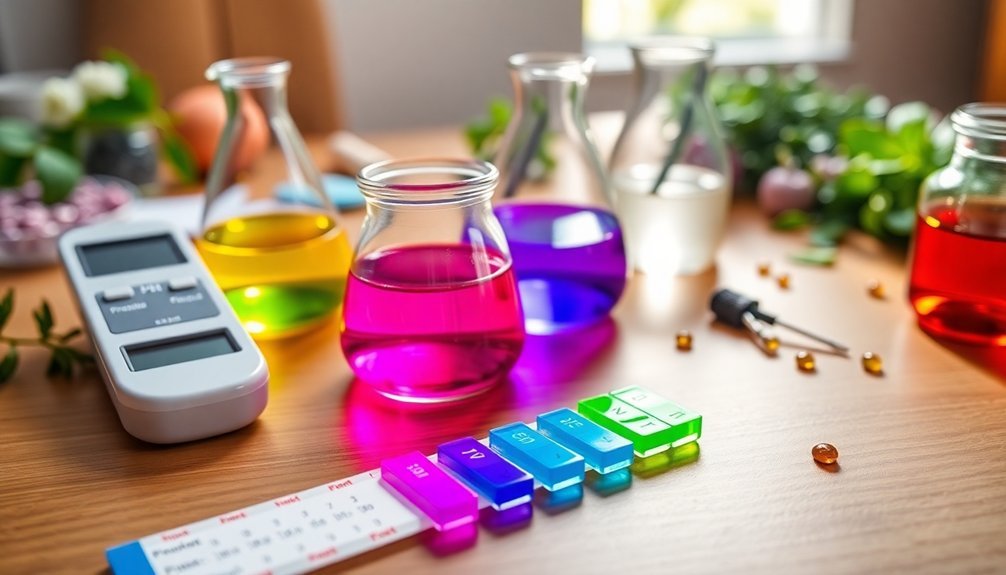
Five essential pH testing tools can transform your handmade cleanser production from guesswork to precision.
pH strips offer an accessible starting point for beginners, providing quick assessments though they sometimes lack precision.
For more accurate readings, invest in a pH meter—it's pricier but delivers the exactness needed for professional-grade products.
Phenolphthalein drops work well during hot process soap making, letting you monitor pH changes in real-time.
Hydrion pH papers provide simple application with broader detection capabilities than standard strips.
Lab Rat Supplies pH strips offer versatility for testing various soap formulations across wide pH ranges.
Remember to dilute your soap samples in distilled water before testing, as direct application often yields inaccurate results.
Proper technique matters as much as the tool you're using.
Creating a 1% soap solution is crucial for obtaining reliable pH measurements when testing handmade soap.
Precision Scales: Ensuring Formulation Accuracy
When selecting precision scales for your cleanser formulations, you'll need to choose between digital options offering precise readouts and manual balances requiring more skill but often proving more durable.
You must establish regular calibration routines using certified weights to maintain accuracy, ideally calibrating before each formulation session or at minimum weekly. Remember that proper calibration enhances the overall accuracy of your weighing scale and ensures consistent product quality.
Consider your typical ingredient quantities to determine the appropriate weight range, ensuring your scale can accurately measure both tiny amounts of potent ingredients and larger quantities of base materials.
Digital vs. Manual Options
Although both types serve the same fundamental purpose, digital scales offer significant advantages over their manual counterparts when formulating handmade cleansers. Digital options provide higher accuracy—often measuring to 0.01g—which is essential for consistent product quality.
You'll appreciate features like tare functions, multi-unit capabilities, and clear LCD displays that reduce measurement errors.
While manual scales might seem appealing due to their lower initial cost and independence from power sources, they're limited by single-unit measurements and deteriorating precision over time.
For your cleanser business, consider the long-term benefits of digital scales. Their precision remains stable, unlike mechanical springs that degrade with use and moisture exposure. Quality digital scales with continuous power sources are preferable to avoid interruptions during critical measurements.
Though the upfront investment is higher, digital scales typically prove more cost-effective through improved accuracy, productivity, and longevity.
Calibration Best Practices
Proper calibration serves as the foundation for all precision measurements in handmade cleanser production.
To maintain accuracy, establish a regular calibration schedule based on your scale's usage frequency and manufacturer recommendations. Performing calibration in a controlled environment is crucial for obtaining accurate and reliable measurements.
Always use certified calibration weights for the most reliable results. Between formal calibrations, perform quick verification checks to catch any accuracy drift early.
Remember that environmental factors like temperature and humidity can markedly impact your scale's performance.
Document all calibration activities meticulously—this helps with regulatory compliance and allows you to spot potential issues before they affect your products.
For legal-for-trade scenarios, verify you're following NIST Handbook 44 guidelines.
Well-maintained and properly calibrated scales aren't just good practice—they're essential for consistent product quality and customer satisfaction in your handmade cleanser business.
Weight Range Considerations
Beyond calibration, selecting scales with appropriate weight ranges directly impacts your formula's consistency and quality.
You'll need to match your scale's capacity to your specific production needs—from precise measurements of essential oils to larger batches of base ingredients.
Consider both the maximum weight capacity and the minimum readable increment. For small essential oil measurements, you'll require scales with readability down to 0.01g or 0.001g, while bulk ingredients may need platform scales with higher capacities.
Remember that environmental factors like temperature and humidity can affect accuracy, particularly for high-precision measurements. Advanced load cell technology and SAW (Surface Acoustic Wave) features provide superior stability and repeatability when measuring critical ingredients. Digital indicators with high-resolution displays offer clear readings that eliminate measurement errors during your formulation process.
Choose scales with overload protection if you're working in busy production environments to guarantee longevity and consistent performance.
Temperature Monitoring Devices for Soap Stability
When creating handmade cleansers, maintaining precise temperature control isn't just beneficial—it's essential for guaranteeing product stability and quality. Temperature fluctuations can greatly impact your soap's hardness, lather, and overall performance.
Invest in high-accuracy thermal sensors or data loggers to track temperature conditions during stability testing. Look for devices with digital displays and sufficient storage capacity for long-term monitoring. For thorough testing, consider combination sensors that simultaneously monitor humidity levels—another critical factor affecting soap stability.
During production, you'll want to conduct both real-time monitoring at room temperature and accelerated stability studies at elevated temperatures to predict long-term performance. Recent research demonstrates that soap films can experience temperature decreases of up to 8°C due to evaporation effects, which significantly influences final product characteristics. Choose devices with user-defined alarms to alert you when conditions exceed acceptable ranges.
This proactive approach prevents costly product failures and guarantees your handmade cleansers maintain their intended properties.
Texture Analysis Equipment for Consistent Products
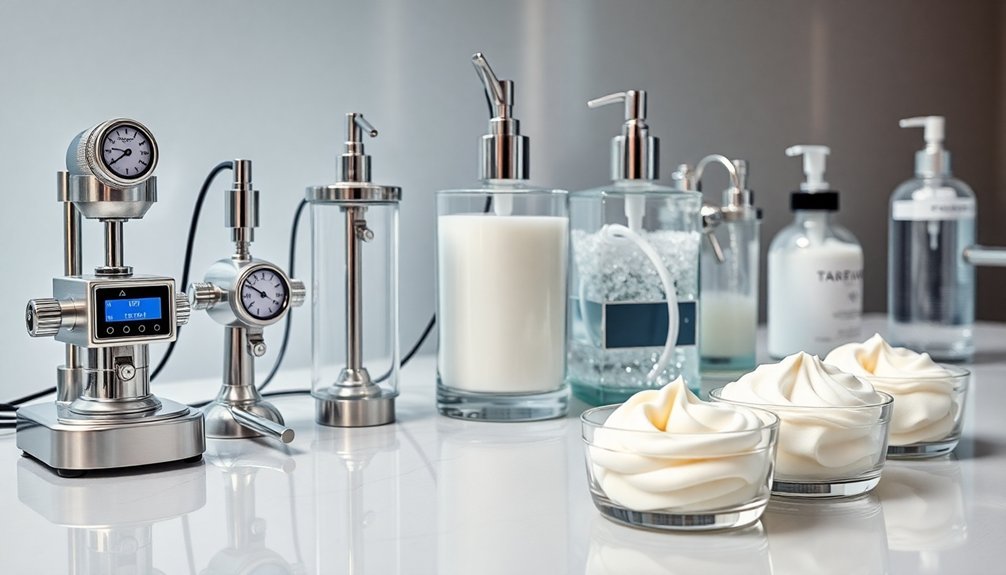
You'll need specialized texture analysis equipment to guarantee your handmade cleansers maintain consistent quality across batches.
Viscosity measurement tools help you monitor flow properties, while droplet size analyzers provide insights into emulsion stability and product performance.
Shear strength testing equipment evaluates how your cleansers respond to force, revealing important data about their durability and application characteristics. A Texture Analyser provides objective measurements that eliminate errors from subjective manual testing, offering consistent testing conditions and precise differentiation between product samples.
Viscosity Measurement Tools
Although successful cleanser formulation requires creativity, achieving consistent product quality demands precision through proper viscosity testing. For your handmade cleansers, several measurement options exist depending on your needs and budget.
Rotational viscometers like the industry-standard Brookfield are ideal for non-Newtonian soaps and lotions, providing quick, reliable readings. Rheometers offer additional insights into compound stability under various conditions that affect product performance. If you're working with Newtonian liquids, glass capillary or Ubbelohde viscometers offer cost-effective alternatives without calibration requirements.
For beginners, manual methods can suffice – timing flow between marked points or comparing to common liquids like water. Small-batch crafters might consider spring-type viscometers for quick checks.
Remember that proper viscosity guarantees product consistency, manufacturing efficiency, and ultimately, customer satisfaction. Your choice of measurement tool should balance precision needs against production scale and budget constraints.
Droplet Size Analysis
Beyond viscosity measurements, droplet size analysis forms the cornerstone of quality control for emulsion-based cleansers.
Understanding how your formulation's droplet size affects stability and appearance will help you create consistent, high-quality products. Several accessible techniques can provide valuable insights into your cleansers' microstructure.
For your handmade cleansers, consider these analysis options:
- Laser Light Scattering (LLS) – Non-destructive measurement that's ideal for nanoemulsions and provides detailed distribution data.
- HORIBA Particle Analyzers – Tools like the SZ-100V2 measure both particle size and zeta potential, essential for stability assessment.
- Bruker minispec – Utilizes NMR technology for fast analysis of emulsion properties with user-friendly software like GoScan.
Proper droplet size control guarantees your cleansers maintain ideal texture, appearance, and stability throughout their shelf life. Typical nanoemulsions used in skin care formulations have droplet sizes ranging from 20 to 500 nm, which contributes to their transparency and effectiveness.
Shear Strength Testing
While droplet analysis reveals the microscopic structure of your cleanser emulsions, shear strength testing focuses on how your products perform under mechanical stress—directly affecting how they feel in customers' hands.
For handmade cleansers, consider investing in a small texture analyzer with appropriate attachments like V-shaped blades or wire shear cells. These devices measure critical properties including hardness, spreadability, and consistency—all key factors in customer satisfaction.
You'll want to test your formulations across various temperatures to ascertain stability in different environments. Measuring the shear storage modulus at temperatures ranging from 20°C to 60°C can help determine your product's thermal stability. Regular testing helps maintain consistency between batches and identifies potential issues before products reach customers.
Though professional analyzers can be costly, they're valuable for quality control and product development. Alternatively, you might explore rheometers which offer complementary data about your cleanser's flow properties under different conditions.
Microbial Testing Kits for Safety Verification
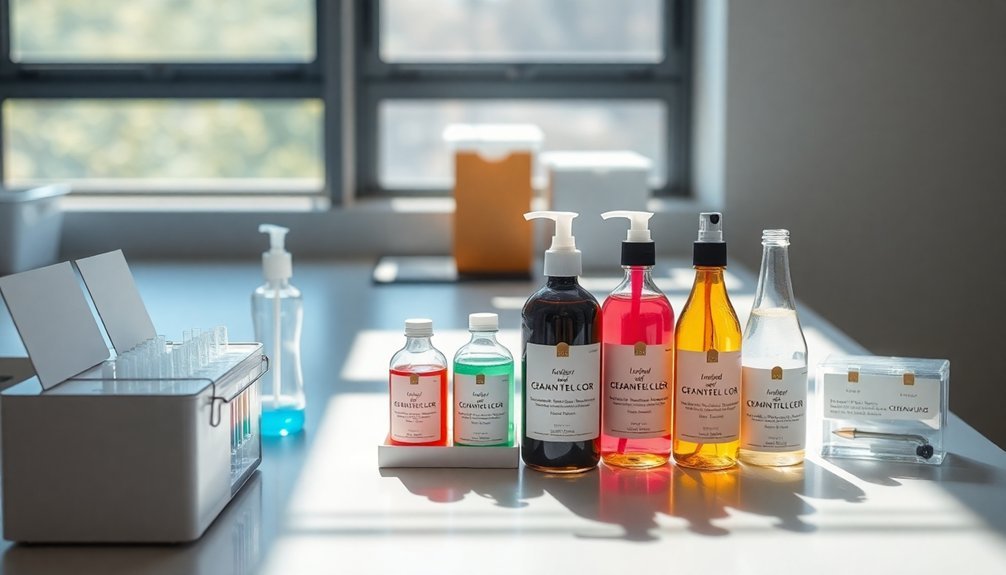
When creating handmade cleansers, ensuring your products are free from harmful microorganisms is essential for consumer safety. Microbial test kits offer an accessible way to verify your formulations aren't harboring bacteria, yeast, or mold before distribution.
These user-friendly kits typically include:
- Sterile swabs for sampling semi-solid products like creams and lotions
- Dip slides for testing liquid formulations
- Color charts for easy interpretation of results without specialized training
You'll find kits designed specifically for cosmetic and personal care testing that contain specialized agars like Rose Bengal for detecting different microorganisms. Some advanced options like Sporicidin deliver fast results in just one minute, helping you make timely decisions about your product safety.
While incubators speed up results (typically 24-48 hours), many kits can be evaluated without them. They're cost-effective compared to professional lab testing, making them ideal for small-batch producers seeking quality control assurance.
Shelf-Life Assessment Tools and Methods
Determining your handmade cleanser's shelf life requires specific tools and methodologies to guarantee products remain safe and effective throughout their intended lifespan.
You'll need pH meters to monitor stability, as fluctuations can trigger ingredient degradation. Water activity meters measure available moisture that microbes need to thrive, helping predict contamination risks.
Invest in accelerated stability chambers that simulate various environmental conditions, providing shelf-life estimates in weeks rather than months.
For preservative efficacy testing, microbial challenge kits help verify your formula's resistance to common contaminants. Clear glass containers allow visual monitoring of separation, discoloration, or texture changes over time.
Document changes systematically with standardized photography equipment and observation logs. Regular monitoring for signs of rancidity is essential for oil-based cleansers to ensure they remain safe for customer use.
Remember that proper packaging—airless pumps or UV-resistant bottles—often extends shelf life considerably by protecting contents from exposure.
Viscosity Measurement Techniques for Liquid Soaps
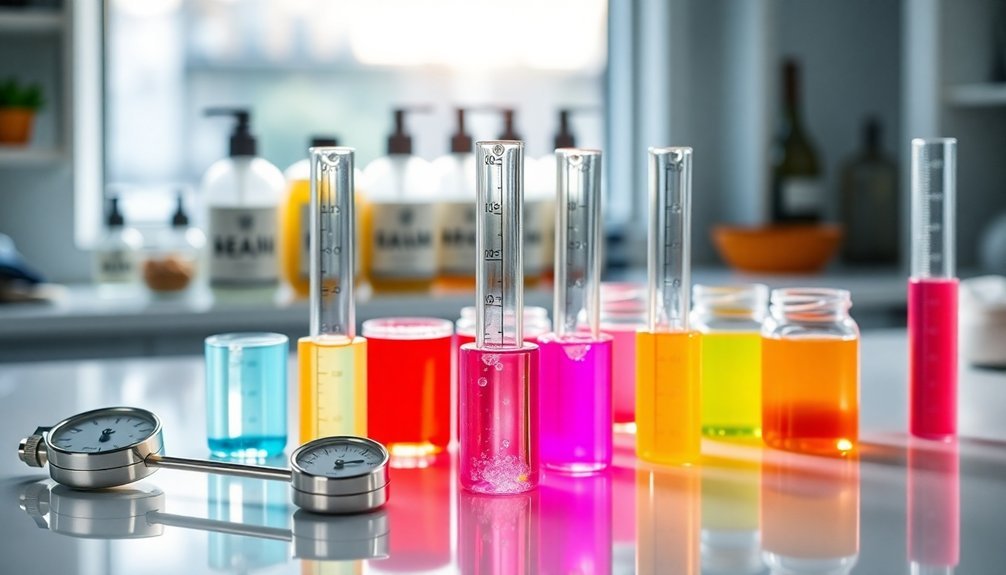
Understanding viscosity provides an essential foundation for creating consistent liquid soaps with ideal flow characteristics. As you develop formulations, you'll need reliable methods to measure how your soap resists flow.
Rotational viscometers are particularly valuable for liquid soaps, offering adjustable shear rates suitable for non-Newtonian fluids.
For accurate measurements, you'll want to take into account:
- Equipment selection – Choose between rotational viscometers for everyday testing, falling ball viscometers for Newtonian formulations, or rheometers for complex behavior analysis.
- Proper calibration – Use certified standard oils and maintain optimal torque readings (20-90%).
- Consistent conditions – Control sample temperature and volume to guarantee your measurements remain comparable across batches.
Regular viscosity testing guarantees product consistency and helps perfect your soap's pour and dispense characteristics. Proper viscosity evaluation becomes especially crucial when working with high coconut oil formulations that require careful water adjustments during dilution.
Packaging Compatibility Testing Equipment
You'll need specific equipment to test how your handmade cleansers interact with potential packaging materials, including FTIR spectroscopy devices for chemical migration detection and environmental chambers for accelerated stability testing.
Container integrity testers like leak detectors and pressure differential systems help you identify potential failures before your products reach customers. Accelerated testing methods are commonly used for efficiency when evaluating long-term product-package interactions.
For shelf stability assessment, invest in temperature-controlled chambers and light exposure units to simulate various storage conditions your products might encounter.
Material Interaction Tests
When creating handmade cleansers, the relationship between your product and its packaging can make or break your formula's stability and shelf life.
You'll need equipment to assess how your cleansers interact with potential containers over time.
Essential testing tools include:
- pH meters and test strips – Monitor changes in acidity that may indicate chemical reactions between your formula and packaging
- Digital scales (0.01g precision) – Detect subtle weight loss from evaporation or container permeability
- Climate chamber or incubator – Simulate various temperature conditions (-20°C to 50°C) to evaluate packaging performance in different environments
These tests should continue for 4-12 weeks to capture long-term effects. Regular assessment schedules can help identify unpredictable interactions between your cleanser chemicals and packaging materials before they become problematic.
Container Integrity Evaluation
Reliable packaging integrity is essential for preserving your handmade cleansers' quality and preventing contamination. For small-batch testing, you'll find simplified versions of professional equipment like pressure decay systems useful for checking your containers.
Consider investing in basic leak detection tools that can identify defects in bottles, jars, and flexible packaging. Even without expensive analyzers like Multi-Q or LIGHTHOUSE, you can perform water immersion tests to check for air bubbles indicating leaks. Basic quality inspection methods can offer non-destructive testing similar to professional systems while being more accessible for small businesses.
Test your packaging under various conditions, especially if your products contain ingredients that might interact with containers. For flexible packaging like pouches or sachets, make certain seals remain intact by applying gentle pressure.
While industrial equipment detects micron-level defects, your goal is to verify basic integrity that maintains product sterility and prevents leakage during shipping and storage.
Shelf Stability Assessment
After securing your containers against leaks, the next key challenge involves determining how your cleansers will hold up over time.
Shelf stability equipment helps you predict product lifespan and maintain quality through simulated environmental conditions.
For handmade cleansers, consider these testing options:
- Stability chambers – Control temperature (typically -10°C to 100°C) and humidity (10-98% RH) to simulate various storage environments your products might encounter.
- Accelerated aging equipment – Compress months of shelf life into weeks by exposing products to intensified conditions.
- Light stability testers – Evaluate how UV and daylight exposure affects your cleanser's color, fragrance, and efficacy.
You don't need laboratory-grade equipment to start. For more advanced testing, consider LUM instruments which offer accelerated stability tests that accurately determine how your products change over time.
Even consistent storage in varied household conditions with regular documentation can provide valuable stability insights for small-batch producers.
Preservation Efficacy Verification Systems
To guarantee your handmade cleansers remain safe throughout their shelf life, preservation efficacy verification systems play an essential role in validating antimicrobial protection.
These systems help you assess whether your preservative choices effectively combat common microorganisms like *S. aureus*, *E. coli*, and *C. albicans*.
For small-batch producers, you'll need access to equipment that allows for proper microbial challenge testing.
Consider investing in neutralization media, controlled incubation chambers, and tools for microbial enumeration.
While professional lab services can perform ISO 11930 or USP <51> compliant testing, affordable alternatives include simplified test kits that indicate preservative performance.
Remember that different formulation matrices require specific testing adaptations to guarantee accurate results and regulatory compliance.
Monitor microbial reduction at 7, 14, and 28-day intervals for thorough efficacy assessment. This timeline aligns with ISO 11930 standards which evaluate antimicrobial protection specifically for cosmetic products.
Sensory Evaluation Tools for Consumer Experience
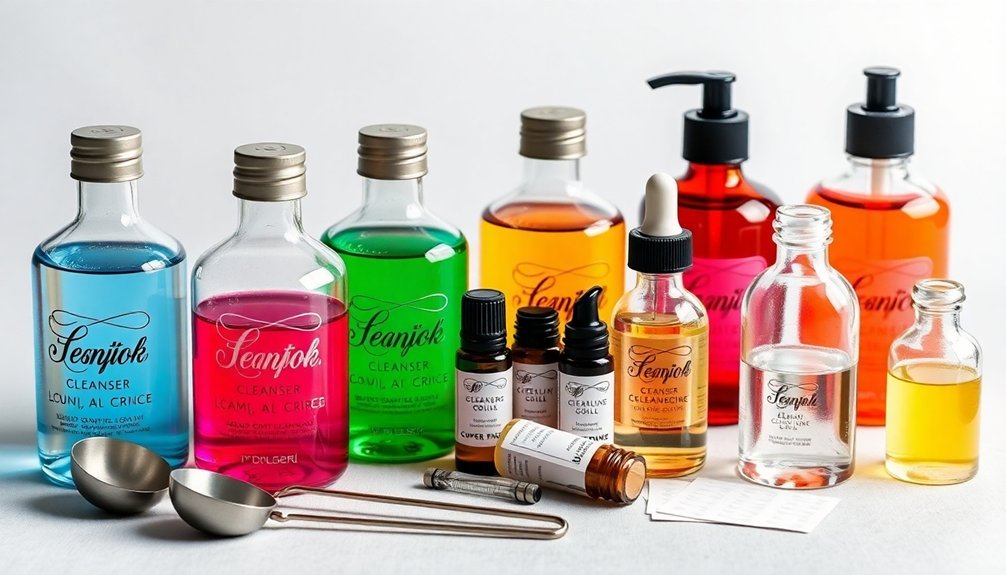
Successful handmade cleansers must delight consumers across multiple sensory dimensions, making proper evaluation tools essential for product refinement.
You'll need equipment that captures both immediate reactions and long-term user experiences.
To effectively evaluate your cleansers, consider these key tools:
- JAR (Just About Right) scales – Simple scorecards measuring critical attributes like foam quality, scent intensity, and skin feel that help you identify when formulations hit the sweet spot.
- In-home usage test kits – Packages containing product samples, detailed questionnaires, and instructions for gathering authentic feedback in real-world settings.
- Temporal evaluation tools – Time-intensity recording systems that track how sensory attributes like fragrance or moisturizing effects evolve during and after use.
These tools will help you create cleansers that consistently meet consumer expectations while providing objective consumer insights that give your handmade products a competitive edge in the market.
Frequently Asked Questions
How Often Should I Calibrate My Testing Equipment?
You should calibrate your testing equipment annually, before major projects, after impacts or environmental changes, and according to manufacturers' specifications. Your usage frequency and industry requirements may suggest more frequent calibrations.
Can I Substitute Professional Tools With Household Alternatives?
Yes, you can substitute some professional tools with household alternatives for small batches, but you'll sacrifice precision, consistency, and scaling capability. For serious production, professional equipment remains the better investment.
What Testing Equipment Requires Special Storage Conditions?
For testing equipment, you'll need to specially store temperature-controlled chambers, light exposure systems, and electronic testing tools. They're sensitive to environmental changes and often require calibrated, controlled settings to maintain accuracy and functionality.
Are There Portable Testing Devices for Small Batch Production?
Yes, you'll find many portable testing options for small batch production, including articulated arms, laser trackers, handheld scanners, YSI ProSample water testers, and DX4085 Z-Meter devices for thermoelectric component testing.
Which Equipment Is Essential Versus Nice-To-Have for Beginners?
For beginners, you'll need a lab balance, basic mixing tools, heat control devices, protective gear, and containers. Nice-to-haves include immersion blenders, pipettes, homogenizers, magnetic stirrers, and pH meters for enhanced formulation capability.
In Summary
You'll transform your handmade cleanser production with the right testing equipment. By investing in pH meters, precision scales, and temperature monitors, you're ensuring consistent, safe products every time. Don't overlook microbial testing and preservation verification—they're essential for customer safety. Remember, quality testing isn't just about compliance; it's about creating cleansers your customers will trust and love. Start building your testing toolkit today.

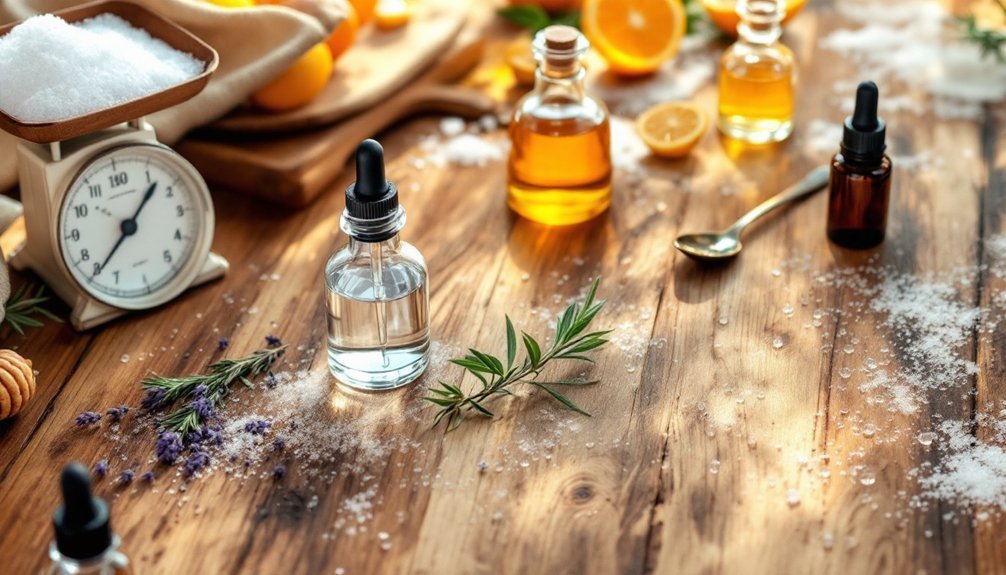



Leave a Reply